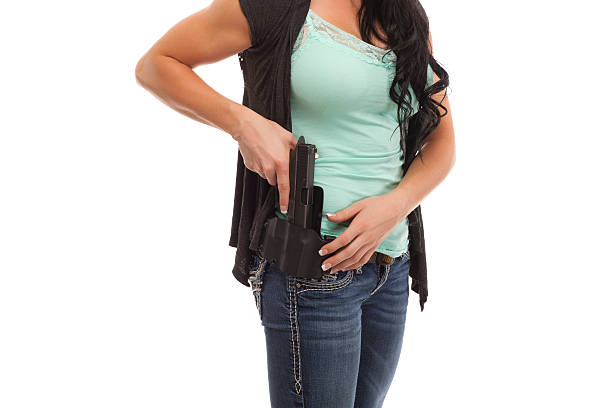Contents
hide


Gun strap holsters serve as essential accessories for firearm owners, offering a secure and accessible means of carrying handguns. Whether you’re a novice, a seasoned enthusiast, or a law enforcement professional, understanding the nuances of gun strap holsters is crucial. In this comprehensive guide, we’ll delve into every aspect of gun strap holsters, from their purpose and various types to materials used in manufacturing, selection considerations, safety protocols, and maintenance practices. Additionally, we’ll explore how the evolution of holster design has adapted to modern needs, ensuring that users can carry their firearms safely and comfortably in various situations.
Gun strap holsters come in a variety of designs, each tailored to meet different needs and preferences. Three primary types include shoulder holsters, belt holsters, and ankle holsters. Shoulder holsters, with their horizontal positioning under the arm, offer excellent concealment options, while belt holsters provide accessibility and comfort by attaching directly to the user’s belt. Ankle holsters, on the other hand, offer discreet carrying options, making them ideal for individuals requiring deep concealment or carrying a backup weapon. Understanding the advantages and disadvantages of each type allows users to make informed decisions based on their specific requirements and preferences.
At its core, a gun strap holster is designed to securely hold a handgun while providing quick access when needed. This essential accessory enables users to carry their firearms comfortably and safely, whether for self-defense, recreational shooting, or professional duties. By keeping the firearm close to the body and in a predetermined position, a holster minimizes the risk of accidental discharge and ensures the weapon remains readily available when required. Furthermore, gun strap holsters offer a level of convenience and peace of mind, allowing individuals to confidently carry their firearms in various environments while maintaining control and accessibility at all times. Whether navigating urban settings, engaging in outdoor activities, or performing daily tasks, the presence of a reliable holster ensures that firearm owners can respond swiftly and effectively to any situation that may arise.

Gun strap holsters come in a variety of designs, each tailored to meet different needs and preferences. Three primary types include:
These holsters consist of straps worn over the shoulder, with the firearm positioned horizontally under the arm. They offer excellent concealment options, especially when wearing jackets or coats, and distribute the weight of the firearm evenly across the upper body. Shoulder holsters are also favored by individuals who spend extended periods seated, such as drivers or desk workers, as they provide a comfortable and accessible carrying solution without restricting movement.
Belt holsters attach directly to the user’s belt and typically position the firearm on the hip or waistline for easy access. They are popular among law enforcement officers and civilian carriers alike for their accessibility and comfort. Belt holsters are versatile, allowing users to adjust the positioning of the firearm for optimal comfort and concealment, making them a practical choice for everyday carry in various environments.
Designed to be worn around the ankle, these holsters provide a discreet carrying option, particularly for smaller handguns. Ankle holsters are favored by individuals who require deep concealment or those who prefer to carry a backup weapon. While ankle holsters offer excellent concealment, they may require some practice to draw the firearm efficiently, and users should be mindful of comfort and accessibility when choosing this option for everyday carry.
Gun strap holsters are crafted from a variety of materials, each with its own set of advantages and disadvantages:
Traditional and durable, leather holsters offer a classic appearance and mold to the shape of the firearm over time. However, they may require break-in periods and can be susceptible to moisture damage. Additionally, leather holsters often develop a unique patina with age, adding character to the accessory and enhancing its aesthetic appeal.
Lightweight and affordable, nylon holsters are popular for their versatility and resistance to water and sweat. However, they may lack the durability of leather and may not provide as snug a fit for the firearm. Despite this, nylon holsters are favored by many for their ease of maintenance and wide range of available colors and patterns.
Known for its rigidity and retention properties, Kydex holsters offer excellent firearm security and are resistant to moisture and temperature changes. However, they may lack the aesthetics of leather and can be noisy when drawing the firearm. Despite these drawbacks, Kydex holsters are highly customizable, allowing users to tailor the fit and retention to their specific firearm model, making them a popular choice among tactical and competitive shooters.
Ensure the holster is compatible not only with the dimensions of your firearm but also with its specific model and any attached accessories, such as lights or lasers. Additionally, consider the weight distribution of the firearm to ensure comfortable carry throughout the day. A well-fitted holster will not only securely retain your firearm but also distribute its weight evenly to prevent discomfort or fatigue.
Consider not only where on your body you prefer to carry the firearm but also your dominant hand and any physical limitations you may have. Experimenting with different carry positions allows you to find the most ergonomic and accessible option for your unique needs and lifestyle. Whether you prefer appendix, hip, or small of the back carry, selecting a holster that accommodates your preferred position enhances comfort and ensures quick access in critical situations.
Selecting a holster that seamlessly integrates with your everyday attire is essential for maintaining both comfort and concealment. Consider factors such as the thickness and material of your clothing, as well as your typical daily activities, to choose a holster that provides effective concealment without sacrificing accessibility. Opting for low-profile holsters that minimize printing and offer adjustable cant and ride height allows you to confidently carry your firearm while maintaining a discreet appearance in any setting.
Safety should always be paramount when using a gun strap holster. Follow these essential guidelines:
Keep your finger off the trigger and outside the trigger guard until you are ready to fire. Practice proper trigger discipline to prevent accidental discharges and ensure safe firearm handling. Remember to maintain constant awareness of your trigger finger’s position, especially during stressful situations, to minimize the risk of unintentional firing.
Ensure the holster provides adequate retention to prevent accidental firearm discharge. Test the retention of your holster regularly and adjust as needed to maintain firearm security. Additionally, consider factors such as holster material, retention mechanisms, and carry position to ensure optimal retention under various conditions, including physical activity or sudden movements.
Ensure the holster provides adequate retention to prevent accidental firearm discharge. Test the retention of your holster regularly and adjust as needed to maintain firearm security. Additionally, consider factors such as holster material, retention mechanisms, and carry position to ensure optimal retention under various conditions, including physical activity or sudden movements.
To prolong the lifespan of your holster and ensure optimal performance, follow these maintenance tips:
Regular cleaning is essential to ensure the longevity and effectiveness of your holster. In addition to removing dirt, debris, and sweat buildup, cleaning also helps prevent the growth of bacteria that could potentially damage the holster material. By incorporating regular cleaning into your maintenance routine, you can maintain a clean and hygienic holster for optimal performance.
Applying leather conditioner not only keeps the material supple and prevents cracking but also helps to restore moisture lost over time. Conditioning leather holsters not only extends their lifespan but also enhances their appearance, ensuring they remain both functional and aesthetically pleasing. Remember to apply conditioner evenly and allow it to penetrate the leather thoroughly for maximum effectiveness.
Regularly inspecting your holster for signs of wear or damage is crucial for maintaining firearm security. Pay close attention to areas of high stress or friction, such as the trigger guard and retention mechanism, as these are prone to accelerated wear. Promptly addressing any issues identified during inspection helps prevent malfunctions and ensures your holster remains reliable and secure during firearm carry.
In conclusion, mastering the use of a gun strap holster is not only essential for firearm owners but also a responsibility that comes with the privilege of carrying a firearm. By comprehensively understanding the purpose, types, materials, selection considerations, safety protocols, maintenance practices, and insights from experts, individuals can elevate their preparedness and confidence in handling firearms in diverse scenarios. Moreover, by consistently practicing proper holstering and drawing techniques, adhering to safety guidelines, and maintaining their holster in optimal condition, users can ensure not only their own safety but also the safety of those around them, fostering a culture of responsible firearm ownership and carry.
Frequently Asked Questions
Q1.Why is mastering the use of a gun strap holster important for firearm owners?
Understanding how to effectively use a gun strap holster ensures that firearm owners can safely and securely carry their weapons, minimizing the risk of accidents and ensuring readiness in critical situations.
Q2.What factors should I consider when selecting a gun strap holster?
When choosing a holster, consider factors such as gun size, carry position preference, and clothing style to ensure optimal comfort, accessibility, and concealment.
Q3.How can I maintain my gun strap holster to prolong its lifespan?
Regular cleaning, conditioning (for leather holsters), and inspecting for wear are essential maintenance practices that help extend the lifespan of a holster and ensure its continued effectiveness.
Q4.Why is trigger discipline important when using a gun strap holster?
Keeping your finger off the trigger and outside the trigger guard until you’re ready to fire prevents accidental discharges, minimizing the risk of injury to yourself and others.
Q5.How can I enhance my confidence and proficiency in using a gun strap holster?
Consistent practice of proper holstering and drawing techniques, adherence to safety guidelines, and seeking insights from experts can significantly boost confidence and proficiency in handling firearms with a holster, fostering responsible firearm ownership and carry.
Get our latest news straight into your inbox

Leave a Reply